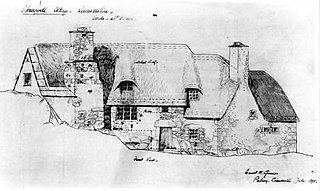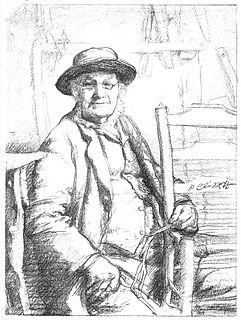
The Arts and Crafts movement was an international trend in the decorative and fine arts that developed earliest and most fully in the British Isles and subsequently spread across the British Empire and to the rest of Europe and America.

Eileen Gray was an Irish architect and furniture designer who became a pioneer of the Modern Movement in architecture. Over her career, she was associated with many notable European artists of her era, including Kathleen Scott, Adrienne Gorska, Le Corbusier, and Jean Badovici, with whom she was romantically involved. Her most famous work is the house known as E-1027 in Roquebrune-Cap-Martin, France.

Selwyn Image was an important British artist, designer, writer and poet associated with the Arts and Crafts Movement. He designed stained-glass windows, furniture, embroidery, and was an illustrator of books. Image was the seventh Slade Professor of Fine Art at Oxford from 1910 to 1916.

John Bly, , is an antiques dealer, author, after-dinner speaker and broadcaster who is best known from the BBC's Antiques Roadshow TV program (UK).

Ernest William Gimson was an English furniture designer and architect. Gimson was described by the art critic Nikolaus Pevsner as "the greatest of the English architect-designers". Today his reputation is securely established as one of the most influential designers of the English Arts and Crafts movement in the late nineteenth and early twentieth centuries.
The Guild of St Joseph and St Dominic was a Roman Catholic community of artists and craftspeople founded in 1920 in Ditchling, East Sussex, England. It was part of the Arts and Crafts movement and its legacy led to the creation of Ditchling Museum of Art + Craft.

Sir (Sydney) Gordon Russell, was an English designer, craftsman and educationist.
Ercol is the name of a British furniture manufacturer. The firm dates back to 1920, when it was established in High Wycombe, Buckinghamshire, as Furniture Industries by Lucian Ercolani (1888–1976).
Wartski is a British family firm of antique dealers specialising in Russian works of art; particularly those by Carl Fabergé, fine jewellery and silver. Founded in North Wales in 1865, the business is located at 60 St James's Street, London, SW1. The company holds royal appointments as jewellers to the Queen and the Prince of Wales.
Peter Waals, born Pieter van der Waals, was a Dutch cabinet maker associated with the Arts and Crafts movement.

Ernest Townsend was a portrait artist from Derby in England.
Corin Mellor is a designer specializing in silverware, tableware and furniture. Son of the biographer Fiona MacCarthy and the cutlery designer David Mellor, he succeeded his father on his retirement in 2002 as creative director of the family-owned manufacturing and retailing company David Mellor Design.
Mallett Antiques is an antiques dealer with galleries in London and New York who regularly exhibit at the International Fine Art & Antique Fairs.

Bernard II van Risamburgh, sometimes Risen Burgh was a Parisian ébéniste of Dutch and French extraction, one of the outstanding cabinetmakers working in the Rococo style. "Bernard II's furniture is brilliant in almost every respect. His carcasses are beautifully shaped, his mounts and marquetry are always in complete balance even when extremely elaborate, and there is a logic to his works that allows the eye to comprehend them effortlessly," wrote Ted Dell.
Philip Thorpe Priestley BSc FSA MBHI was an English scientist and inventor.

Philip Clissett was a Victorian country chairmaker who influenced and inspired the English Arts and Crafts Movement through various architects and designers. His chance meeting with James MacLaren has been described as "undoubtedly a seminal point in the subsequent development of the Arts and Crafts Movement", and led to the furnishing of the meeting room of the Art Workers Guild with a large number of his chairs which can still be seen today. These chairs have been "highly influential", having been "seen by almost everyone involved in art and design from the late 1880s". They particularly influenced Ernest Gimson who, in 1890, spent six weeks with Clissett learning to make ladderback chairs. Clissett's chairs were popular with the Arts and Crafts cognoscenti, and were used by Charles Rennie Mackintosh in early commissions, and by the architectural team of Richard Barry Parker and Raymond Unwin. They were also used as part of the original furnishing of the Passmore Edwards Settlement at Mary Ward House, 5 Tavistock Place, London by the architects A. Dunbar Smith and C. Cecil Brewer.

Charles Henry Truman, FSA, was an art historian and a leading authority on gold boxes.

Simon Rollo Gillespie is a British conservator-restorer of fine art, and an art historian. He is known particularly for his work with Early British and Tudor portraits, although his practice extends across all periods from early paintings to contemporary artworks. Gillespie has been restoring art since 1978, and he appears frequently on the BBC Four series Britain's Lost Masterpieces, having previously appeared on the BBC1 art programme Fake or Fortune.
Nancy Hiller is a cabinetmaker, period furniture maker, and author based in Bloomington, Indiana. Hiller owns and operates NR Hiller Design: Custom Furniture and Cabinetry, teaches woodworking classes, and is the author of several books including Making Things Work: Tales from a Cabinetmaker's Life.
The Guild and School of Handicraft was established in 1888 in London, later moving to Chipping Campden in Gloucestershire, England, as a community of artists and craftspeople by the arts and crafts architect Charles Robert Ashbee (1863-1942). According to Historic England it "became one of the foremost Arts and Crafts workshops of its period .. formed the focus of the communal life which, as a pioneering social experiment, formed the most bold and important expression of Arts and Crafts principles".










